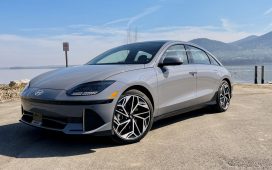On the surface, electric scooter pioneer Bird filing for bankruptcy would seem to be a nail in the coffin for shared micromobility — that nebulous term often used to describe rentable electric bikes and scooters in cities. After a number of mergers and some bad financial management, the OG scooter company is going belly up. That can’t bode well for the future of scooters in general, right?
But actually, shared electric mobility is doing just fine. Sure, the margins are tight and profitability is still rare, but shared scooter and bike companies are becoming more integral to city life in ways we never thought possible.
The only thing that’s dead is the zero-interest rate-influenced era of unhinged investments and wildly skewed valuations that we saw at the end of the last decade. Hopefully now, with Bird filing for Chapter 11, we will see a new era of more responsible management and better pricing in order to ensure these systems remain viable for years to come.
The state of the scooter
Despite Bird’s murky future, cities are really taking to their shared scooters and bikes. But don’t take my word for it — this is according to the National Association of City Transportation Officials’ (NACTO) annual report on the state of play in 2022:
The number of micromobility trips in the U.S. and Canada increased by five million from 2021 and are up by 40% since 2018. In the U.S., shared micromobility continued its pandemic-era recovery, with 113 million trips in 2022, while ridership in Canada blew past pre-pandemic highs, with 17 million trips.
It’s not just 9-to-5 commuters or even just tourists who are taking all these rides. According to NACTO, 34 percent of riders are using bikes and scooters “to access jobs,” while 39 percent are running errands, 16 percent are going to school, and 50 percent for “other social or recreation trips.”
E-bikes, in particular, are becoming more popular, with three-quarters of all station-based systems (docked, as opposed to dockless systems like Bird) in the US and Canada expanding the number of e-bikes in their fleets.
In the US, shared e-bike trips increased from 14.5 million trips in 2021 to 20 million trips in 2022. And while docked e-bikes made up only 9 percent of the micromobility fleet in the US and Canada in 2022, they accounted for 18 percent of total trips. People love their e-bikes!
But NACTO’s assessment of the state of scooter trips is not all wine and roses. There are troubling trends on the horizon, “including volatility amongst private-sector operators and climbing costs for riders.”
This week, we saw one of those predictions play out in real time.
It’s not just Bird
When Bird first began dropping its scooters on the streets of Santa Monica in 2017, the future seemed bright for this new concept of micromobility. Before Bird, we had plenty of so-called docked bikeshare programs, like CitiBike in New York and Divvy Bikes in Chicago.
But these scooters were dockless. They could go everywhere and be left anywhere. And the scooters — off-the-shelf Chinese models from brands like Xiaomi and Segway-Ninebot — were cheap to buy, so Bird could theoretically launch in any city it wanted and start distributing scooters. The only obstacle were cities who had learned a thing or two during the rise of Uber and Lyft and were naturally skeptical of venture capital-based startups claiming to solve the problem with mobility.
But almost immediately, the financial health of shared micromobility came under scrutiny. An early indicator that the mission of cheap, plentiful electric mobility was in danger was the unit economics of the scooter business.
But these scooters were dockless
Cheap as they were, the scooters weren’t lasting on the street long enough to recover their initial costs. They were breaking down, largely because the companies weren’t taking into account the absolute beating these things were taking on a daily basis. People were riding them into the ground and also vandalizing them. Many ended up in lakes or up in trees. A few were set on fire.
So after the initial novelty wore off, the next stage was about right-sizing the industry through purpose-built scooters designed for longer life spans. Bigger, heavier, tougher scooters were the name of the game. Scofflaw city launches gave way to permission-seeking and public-private partnerships. Scooters were relegated to a system of begging cities to pick them for a limited number of pilot permits. The companies that were chosen basked in the glow of their newfound purpose; the losers usually folded.
But after all this spending and sorting, the business of renting a scooter hasn’t really gotten any easier. Bird thought going public would give it the boost it needed, so it merged with one of those special purpose acquisition companies, or SPACs, back when that was the cool thing to do. But it continued to commit unforced errors, losing money, overstating its revenue, and eventually slowly descending into layoffs and irrelevancy.
Other scooter companies have struggled, too. Many have merged with other companies or simply vanished. New technology that seemed poised to fix a lot of the problems with dockless scooters never really caught on. The micromobility industry continues to shift, with some players abandoning two wheels altogether in favor of four.
Where does this leave Lime?
If one company stands to benefit from Bird’s fall, it’s Lime. The San Francisco-based company can now claim to be the biggest micromobility operator in the US. Earlier this year, Lime released a limited set of financial figures (it is still a private company and under no obligation to share most of these numbers) that it claims show its financial future heading in the right direction.
Lime reported gross bookings of $250 million in the first half of the year, a 45 percent increase over the same period last year. It’s also touted an adjusted EBITDA profitability of $27 million — the first time the company has achieved this for the first half of the year and a 45 percent margin increase over last year — and an unadjusted $20.6 million profitability. Still, there’s a lot we don’t know, like revenue and costs.
Lime wasn’t the first to offer shared electric scooters for rent, but it may be the last scooter company standing, especially as others merge and the industry continues to consolidate and evolve.
What’s next?
NACTO wants to see more taxpayer-funded subsidies, or even outright municipal ownership of fleets, in order to stave off any more bankruptcies. Roads need to be redesigned to prioritize less-polluting modes of transportation. That means more protected bike lanes and other fixes to encourage those inclined to two-wheeled forms of conveyance.
A recent positive step is the updating of the Manual on Uniform Traffic Control Devices, the Federal Highway Administration’s 88-year-old rulebook for road building in the US. The long-awaited 11th volume of the book is said to finally address emerging vehicles, like electric bikes and scooters, and will include needed design changes like bike infrastructure and cycle lane design.
But while we wait for those changes, the micromobility industry will continue to scrape by however it can. Bird said it intends to maintain its operations while going through the restructuring process. Though, it’s unclear where this will leave the company’s system of outsourcing its city operations to independent fleet managers. Will the bankruptcy court authorize payments to unsalaried workers? It’s unclear.
Small electric vehicles are just getting started. E-bike sales are continuing to break records. State subsidies are bringing down costs for interested buyers. Shared fleets are a great entry point to personal ownership. Even electric go-karts are becoming popular in certain towns in the southeast.
Bird’s goose may be cooked, but the need for alternatives to polluting cars remains paramount. The federal government is hoping that Tesla and other electric car companies can bail us out of a future marred by climate change. But we need every weapon in our arsenal if we’re going to beat back this existential threat.
And that includes micromobility. Even the dinkiest, dorkiest electric scooters matter in this fight.












